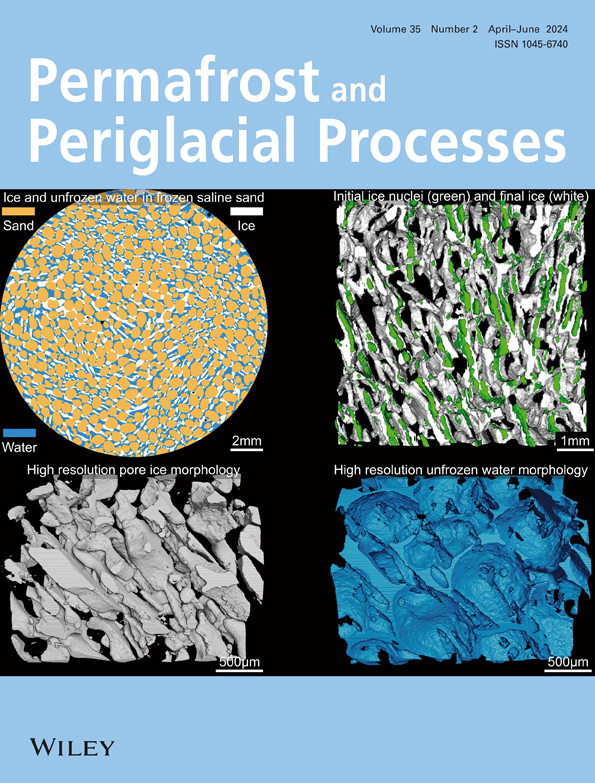Pingo drilling reveals sodium–chloride‐dominated massive ice in Grøndalen, Spitsbergen
IF 3.3
3区 地球科学
Q2 GEOGRAPHY, PHYSICAL
引用次数: 1
Abstract
Drilling of a 21.8‐m‐deep borehole on top of the 10.5‐m‐high Nori pingo that stands at 32 m asl in Grøndalen Valley (Spitsbergen) revealed a 16.1‐m‐thick massive ice enclosed by frozen sediments. The hydrochemical compositions of both the massive ice and the sediment extract show a prevalence of Na+ and Cl− ions throughout the core. The upper part of the massive ice (stage A) has low mineralization and shows an isotopically closed‐system trend in δ18O and δD isotopes decreasing down‐core. Stage B exhibits high mineralization and an isotopically semi‐open system. The crystallographic structure of Nori pingo’s massive ice provides evidence of several large groundwater intrusions that support the defined formation stages. Analysis of local aquifers leads to suggest that the pingo was hydraulically sourced through a local fault zone by low mineralized sodium–bicarbonate groundwater of a Paleogene strata aquifer. This groundwater was enriched by sodium and chloride ions while filtering through marine valley sediments with residual salinity. The comparison between the sodium–chloride‐dominated massive ice of the Nori pingo and the sodium–bicarbonate‐dominated ice of the adjacent Fili pingo that stands higher up the valley may serve as an indicator for groundwater source patterns of other Nordenskiöld Land pingos.Pingo钻探揭示了斯匹次卑尔根Grøndalen以钠-氯化物为主的大块冰
在Grøndalen山谷(斯匹次卑尔根)海拔32米的高10.5米的Nori pingo上钻了一个21.8米深的钻孔,发现了16.1米厚的大块冰,被冰冻的沉积物包围。大块冰和沉积物萃取物的水化学组成均显示Na+和Cl−离子在整个岩心中普遍存在。块状冰上部(A期)矿化程度低,δ18O和δD同位素呈同位素封闭系统递减趋势。B阶段矿化程度高,为同位素半开放体系。Nori pingo巨大冰的晶体结构提供了几次大规模地下水入侵的证据,支持了确定的形成阶段。通过对当地含水层的分析,认为该矿床是由古近系地层含水层的低矿化度碳酸氢钠地下水通过当地断裂带水力形成的。这种地下水在通过残留盐度的海洋山谷沉积物过滤时被钠离子和氯离子富集。Nori pingo以氯化钠为主的大块冰与相邻的Fili pingo以碳酸氢钠为主的冰之间的比较可以作为其他Nordenskiöld陆地pingo地下水来源模式的指标。
本文章由计算机程序翻译,如有差异,请以英文原文为准。
求助全文
约1分钟内获得全文
求助全文
来源期刊
CiteScore
9.70
自引率
8.00%
发文量
43
审稿时长
>12 weeks
期刊介绍:
Permafrost and Periglacial Processes is an international journal dedicated to the rapid publication of scientific and technical papers concerned with earth surface cryogenic processes, landforms and sediments present in a variety of (Sub) Arctic, Antarctic and High Mountain environments. It provides an efficient vehicle of communication amongst those with an interest in the cold, non-glacial geosciences. The focus is on (1) original research based on geomorphological, hydrological, sedimentological, geotechnical and engineering aspects of these areas and (2) original research carried out upon relict features where the objective has been to reconstruct the nature of the processes and/or palaeoenvironments which gave rise to these features, as opposed to purely stratigraphical considerations. The journal also publishes short communications, reviews, discussions and book reviews. The high scientific standard, interdisciplinary character and worldwide representation of PPP are maintained by regional editorial support and a rigorous refereeing system.

 求助内容:
求助内容: 应助结果提醒方式:
应助结果提醒方式:


